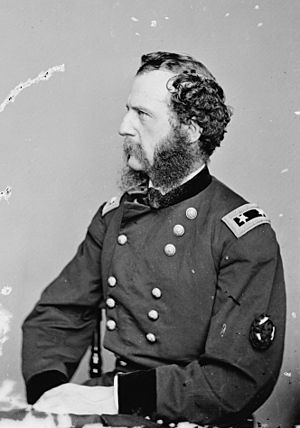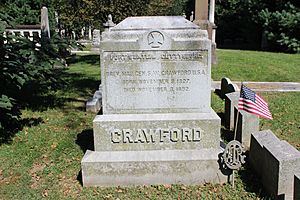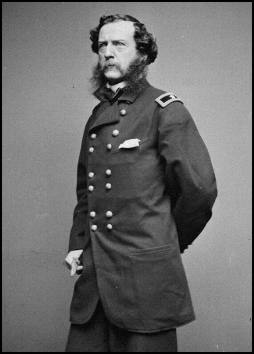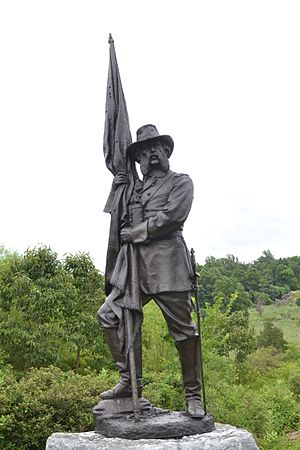Samuel W. Crawford facts for kids
Quick facts for kids
Samuel Wylie Crawford, Jr.
|
|
|---|---|

Samuel W. Crawford
|
|
| Born | November 8, 1829 Franklin County, Pennsylvania, US |
| Died | November 3, 1892 (aged 62) Philadelphia, Pennsylvania, US |
| Place of burial | |
| Allegiance | United States of America Union |
| Service/ |
United States Army Union Army |
| Years of service | 1851–1873 |
| Rank | |
| Commands held | Pennsylvania Reserves |
| Battles/wars | American Civil War |
| Other work | author |
Samuel Wylie Crawford (November 8, 1829 – November 3, 1892) was a doctor in the United States Army. He later became a general for the Union during the American Civil War.
He was a surgeon at Fort Sumter, South Carolina when the war began in 1861. He then joined the infantry and led soldiers in battles. Crawford was wounded at Antietam. He returned to fight at Gettysburg, where his division helped push Confederate soldiers back.
Crawford was one of the few soldiers who was present at both the start and the end of the Civil War. He saw the first shots fired at Fort Sumter. He was also there when Robert E. Lee surrendered at Appomattox Court House in April 1865.
Contents
Early Life and Medical Career
Samuel Crawford was born in Franklin County, Pennsylvania. He went to the University of Pennsylvania and finished his medical studies in 1850. In 1851, he joined the U.S. Army as an assistant surgeon. He worked as a doctor for ten years.
Crawford's Role in the Civil War
Crawford was a surgeon at Fort Sumter, South Carolina, when the Civil War started in 1861. Even though he was a doctor, he helped command some of the cannons firing back from the fort.
From Doctor to General
A month after Fort Sumter, Crawford decided to change his career. He became a major in the 13th U.S. Infantry. In 1862, he was promoted to brigadier general. He led a group of soldiers in the Department of the Shenandoah.
Key Battles and Injuries
Crawford's soldiers first fought during the Northern Virginia Campaign. At the Battle of Cedar Mountain, his group made a surprise attack. They pushed back a Confederate division, but then they were forced to retreat.
At the Battle of Antietam, Crawford was in charge of his division for a short time. He was shot in his right thigh. He stayed on the battlefield until he became too weak from losing blood. It took eight months for his wound to heal.
Gettysburg and Little Round Top
In June 1863, Crawford's division joined the Army of the Potomac for the Gettysburg Campaign. Crawford had been a doctor, not an infantry officer. Also, his soldiers had been on easy duty and were not fully ready for battle.
On July 2, 1863, Crawford and his division arrived at Gettysburg. They were ordered to help at Little Round Top. By the time they got there, the fighting had mostly stopped.
Confederate soldiers had pushed Union defenders back to Plum Run. This area became known as "the Valley of Death." Crawford's division charged down the slope of Little Round Top. Crawford himself grabbed his division's flag and led the charge. The attack was successful, and the Confederates were driven out of the Valley of Death.
Preserving Gettysburg
Even though the fight at Little Round Top was small, Crawford spent the rest of his life proud of it. After the war, he worked hard to protect the Gettysburg Battlefield. He even tried to raise money for a large memorial building on Little Round Top. This plan did not work, but his efforts helped save the battlefield.
Later War Actions
Crawford stayed in command of his division for the rest of the war. During the Richmond-Petersburg Campaign, he was wounded in the chest at the Weldon Railroad.
At the Battle of Five Forks, his division got lost in the woods. This caused his commander, Maj. Gen. Gouverneur K. Warren, to miss part of the attack while looking for them. Crawford was present when Robert E. Lee surrendered at Battle of Appomattox Court House in April 1865. This meant he saw both the start and the end of the Civil War.
Life After the War

Crawford left the Army on February 19, 1873. He was given the rank of brigadier general when he retired. He wrote a book called The Genesis of the Civil War, which was published in 1887. He passed away in Philadelphia, Pennsylvania, and was buried in Laurel Hill Cemetery.
Legacy
In 1988, a statue of Crawford was placed at Gettysburg. It shows him holding a battle-damaged American flag.
Images for kids




